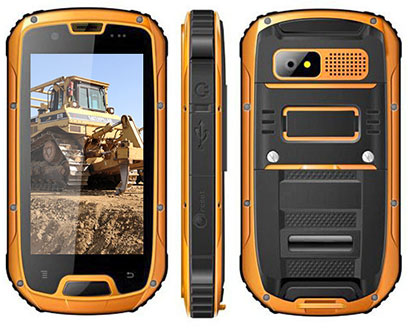Cedar Tree Technologies, launched in 2014 by the founders of Juniper systems and partnering with leading industry software providers, provides rugged Android tablets, handhelds and smartphones for the construction and similar industries. One of their initial products is the strikingly designed, economically priced rugged CT4 handheld computer.

Cedar targets the tough and outdoorsy looking Cedar CT4 as both a contemporary computing platform as well as a smartphone for the field. Running Android on a 4.3-inch multi-touch display, it can serve as the hardware for any number of existing field service, mapping, GIS, asset management and other field solutions apps. And it does so at a cost that's significantly lower than an unlocked consumer smartphone.

Measuring 5.7 x 2.9 inches and less than an inch thick, the CT4 remains pocketable, and it weighs just nine ounces. Its 4.3-inch screen would have looked huge on a phone or handheld just two or three years ago, but in this era of giant consumer phones, the CT4 looks and feels just right, not too small for real work, not too large to get in the way out there in the field.
The display's 960 x 540 pixel resolution is not quite "retina" class, but 240 dpi is still super-sharp and close to that of a 4th gen iPad's 264 dpi. And it's an IPS (In-Plane Switching) screen, which means it has perfect viewing angles from all directions.
As for the technology under the hood, the Cedar CT4 uses a 1.2GHz quad-core Cortex A7 MediaTek MTK6589 processor that's based on the ARMv7 instruction set and also includes an PowerVR GPU. This is a popular chip used in numerous smartphones. There's a gigabyte of RAM and 4GB of Flash for storage, plus what's in the micro SDHC card slot. There is an 8mp documentation autofocus camera with LED flash on the backside, and a 1.2mp vidcam in the front. Cedar claims the unit's 11.1 watt-hour Li-Ion battery allows all-day operation.
For wireless communication there's 802.11 b/g/n WiFi, Bluetooth 2.1, integrated GPS, as well as 3G/3.75G cellular radio. Wired communication includes a micro-USB port and a 3.5mm audio jack.
The CT4's housing and construction is simple but effective. It consists of two plastic halves with protective black overmolding. The two halves are held together by eight screws and made water-tight with a pressure seal around the entire perimeter. The display and electronics are mounted on what looks like a sturdy magnesium base. The internal Li-Ion battery is fixed and non-removable. It looks like it can be replaced, but the unit needs to be opened in order to do so.
The Cedar CT4's dual SIM card slots and its micro SD card slots are user-accessible inside a compartment in the back of the unit. Note that dual SIM here means one for an older style 2G GSM SIM and one for a 3/3.75G WCDMA SIM.
For hardware controls, on its left side the CT4 handheld has the power button, volume up/down, and what appears to be a push-to-talk button. Along the right side are the audio jack and the microUSB port. The three standard Android control buttons (Menu, Home, Back) are beneath the display.
Just how much tougher is the Cedar CT4 than your typical consumer smartphone? Quite a bit. Thanks to its much more rugged construction it can survive drops from up to ten feet, and it's also totally dustproof and waterproof. We're talking IP68 sealing, which means totally dustproof and also protected against full and extended immersion in water. The display is protected by Gorilla Glass from breakage and scratching. What we'd like to see from Cedar, though, is additional ruggedness specs.
What's the price? That'd be US$489, everything included. That's significantly less than the cost of an unsubsidized premium consumer smartphone. Customers might leave their expensive, fragile primary smartphone at home and use the CT4 instead for work on the road and in the field. Cedar offers one-stop service and also extended warranties, increasing the unit's feasibility for vertical market deployments.





